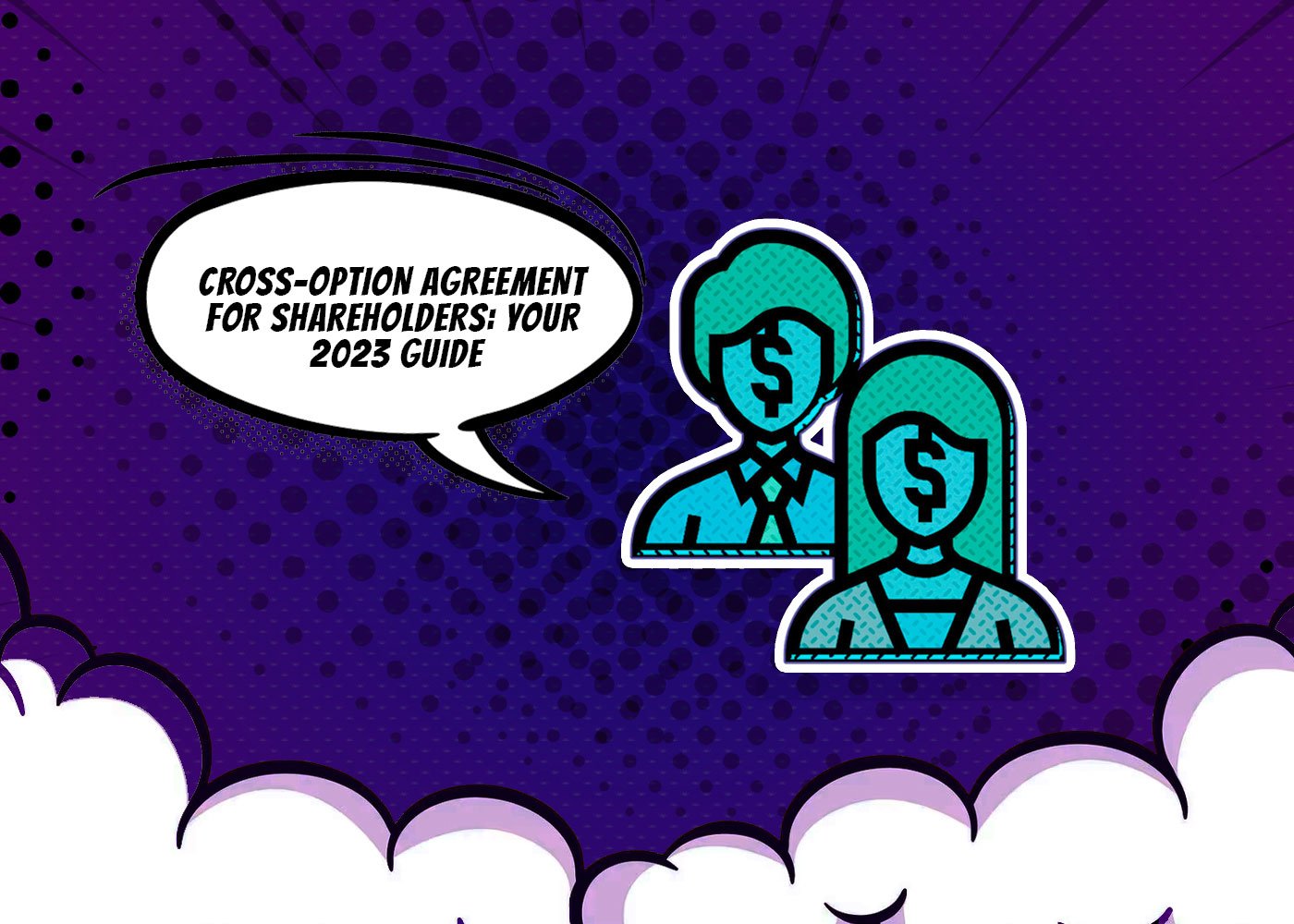A cross-option agreement is something you may have heard of if you own stock in a privately owned corporation. This is a legal instrument that can be used to safeguard stockholders if one of them dies or gets seriously ill. The agreement essentially gives each shareholder the option to purchase the shares of a deceased or severely sick shareholder, and it ensures that the value of those shares is fair and agreed-upon by all parties. In this blog post, we’ll look at cross-option agreements for shareholders in greater detail and give you a detailed guide to understanding and implementing them in your own business. This post will help you manage the complexity of cross-option agreements and make informed decisions about preserving your investments, whether you are a business owner or a shareholder.
What Is a Cross-Option Agreement?
A cross-option agreement is essentially an arrangement between private limited company shareholders that offers each shareholder the option to purchase the shares of another shareholder under specific situations, such as death or critical illness. This is especially significant in private limited corporations, where there are generally few stockholders with a tight relationship.
If one shareholder dies or becomes critically ill, the other shareholders can purchase their shares at a predetermined price under the terms of a cross-option agreement. This price is typically fixed in advance and is based on an agreed-upon valuation approach, such as the company’s net asset value or a multiple of its earnings. This guarantees that the pricing is reasonable and agreed upon by all parties. When a shareholder dies, the opportunity to buy their shares normally falls to their estate or heirs. This guarantees that ownership of the firm remains with individuals who are invested in its success rather than moving to someone who may not share the organization’s vision or aims.
A cross-option agreement is especially important for preserving the interests of minority owners, who would otherwise be at a disadvantage if a majority shareholder died or became seriously ill. It can also help to avoid shareholder disagreements over the value of shares or who should have the right to purchase them.

Key Components of a Cross-Option Agreement:
There are numerous critical components of a cross-option agreement that must be appropriately studied and incorporated into the agreement. These components are as follows:
- Trigger Events: The trigger events that will activate the cross-option agreement must be clearly described in the agreement. These trigger events often include a shareholder’s death or critical illness, but they could also include events like bankruptcy or insolvency.
- Option Price: The price at which the surviving shareholders have the opportunity to purchase the shares of a deceased or seriously ill shareholder must be agreed upon in advance. This price should be based on a fair and unbiased appraisal process that has been agreed upon.
- Exercise Term: The term during which the other shareholders might exercise their option to purchase the shares of a deceased or seriously sick shareholder must also be clearly outlined. This term should be lengthy enough to allow the surviving stockholders to obtain finance if necessary but not so long that the process is excessively slowed.
- Payment Terms: The agreement must describe the payment arrangements for purchasing shares. This includes the payment plan, interest rates, and any other terms that are relevant.
- Shareholder Restrictions: The cross-option agreement may have restrictions on shareholders’ ability to transfer shares. This can assist in ensuring that the shares remain in the hands of shareholders who are dedicated to the company’s long-term prosperity.
- Dispute Settlement: In the event of a conflict or disagreement between the shareholders, the agreement should include procedures for dispute settlement.
- Termination: The agreement must specify the circumstances under which the cross-option arrangement can be terminated. This may include situations in which the company is sold or goes public.
IMPORTANT: Working with a lawyer or other legal practitioner is essential to ensure that the major components of a cross-option agreement are properly specified and included in the agreement. This can help avoid disagreements and ensure the agreement is legally enforceable if any problems emerge.
Advantages and Disadvantages of Cross-Option Agreements:
Cross-option agreements have various advantages and downsides that should be examined before engaging in one.
Advantages:
- Shareholder Protection: One of the primary benefits of cross-option agreements is that they protect shareholders in the event of a shareholder’s death or critical illness. The agreement ensures that ownership of the company remains in the hands of those who are invested in its success rather than passing it to someone who may not share the company’s vision or goals.
- Prevents Disputes: Cross-option agreements can help prevent shareholder disputes over the value of shares or who should have the right to purchase them. The agreement can help minimize disagreements and ensure a smooth transition during a trigger event by agreeing on a valuation method and exercise period in advance.
- Flexibility: Cross-option agreements can be tailored to a company’s and its shareholders’ individual needs. This means that the agreement can be customized to match the company’s ownership structure and the shareholders’ goals.
- Tax Advantages: Cross-option agreements can provide stockholders with tax advantages. If the agreement is structured as a life insurance policy, for example, the premiums may be tax-deductible, and the proceeds may be tax-free.
Disadvantages:
- Cost: Cross-option agreements can be costly to establish and manage, especially if they are structured like life insurance plans. This could be a problem for smaller businesses or those with limited resources.
- Complexity: Cross-option agreements can be complicated, and shareholders may struggle to fully understand the deal’s ramifications. Working with a lawyer or other legal practitioner is essential to ensuring that the agreement is properly constructed and understood by all parties involved.
- Limited Flexibility: Cross-option agreements may restrict shareholders’ capacity to transfer their shares or depart the company. This can be especially difficult if a shareholder decides to sell their shares for personal or financial reasons.
- Uncertainty: The value of the shares may be uncertain, especially if the company’s performance changes considerably after the agreement is signed. This may result in arguments or disputes among shareholders regarding the value of their shares.
How to Set Up a Cross-Option Agreement:
Setting up a cross-option agreement can be a difficult process, and it is critical to consult with a lawyer or other legal practitioner to verify that the agreement is correctly designed and legally enforceable. Here are some general steps to take when establishing a cross-option agreement:
- Identify Trigger Events: The first step is to identify the events that will cause the cross-option agreement to be activated. This often includes a shareholder’s death or critical sickness but could also cover events like bankruptcy or insolvency.
- Agree on a Valuation Approach: The next stage is to agree on a valuation approach for determining the value of the shares. Methods such as net asset value, earnings multiple, and discounted cash flow analysis could be included.
- Determine Option Price: The option price for the other shareholders to purchase the shares of a deceased or seriously ill shareholder can be determined using the agreed-upon valuation technique.
- Define the Exercise Term: The exercise term must be established so that the remaining owners can exercise their option to purchase the shares. This term should be long enough to allow the surviving stockholders to secure finance if necessary but not so long that the process is unreasonably prolonged.
- Consider Payment Terms: The agreement must specify the payment terms for the purchase of shares. This can include the payment plan, interest rates, and any other terms that are pertinent.
- Establish Shareholder Restrictions: The cross-option agreement may include restrictions on shareholder share transfers. This can assist in ensuring that the shares remain in the hands of shareholders who are committed to the company’s long-term success.
- Draft the Agreement: Once the major components of the cross-option agreement have been agreed upon, the agreement can be drafted by a lawyer or other legal practitioner. Before it is finalized, all parties should review and approve the agreement.
- Obtain Life Insurance Policies (Optional): If the cross-option agreement is structured as a life insurance policy, the necessary policies must be obtained and kept for the agreement to be properly funded.
- Review and Update the Agreement on a Regular Basis: It is critical to review and update the cross-option agreement regularly to ensure that it remains current and reflects the firm’s and its shareholders’ needs.
To Sum Up:
Finally, a cross-option agreement can effectively protect shareholders in a trigger event, such as a shareholder’s death or critical illness. The agreement can assist in preventing shareholder conflicts about the value of shares or who should have the right to buy them, and it can also bring tax benefits to shareholders. However, it is critical to carefully consider the benefits and drawbacks of such an agreement and work with a legal professional to ensure that the agreement is properly structured and understood by all parties involved. The agreement should be reviewed and updated on a regular basis to ensure that it stays current and reflects the needs of the firm and its shareholders. Overall, a well-crafted cross-option agreement can give shareholders peace of mind while also ensuring the company’s long-term prosperity.
It may get your attention:
Untangling the Truth: Do Hasidic Jews Pay Taxes?
2023 Income Inequality: What Percentage of the Population Makes Over $300K?






















































































![BitTorrent [New]](https://s2.coinmarketcap.com/static/img/coins/64x64/16086.png)






















